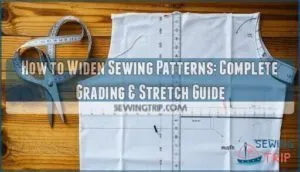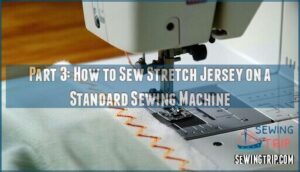This site is supported by our readers. We may earn a commission, at no cost to you, if you purchase through links.

Start by measuring the difference between your body and the pattern, then add that extra width by slashing the pattern pieces vertically and spreading them apart.
For woven fabrics, you’ll need to maintain seam angles and curves.
Stretch fabrics like jersey offer more flexibility since the fabric naturally accommodates your body.
Remember to adjust all corresponding pattern pieces and test with a muslin first.
The secret lies in knowing exactly where to make your cuts and how much to spread each section.
Table Of Contents
Key Takeaways
- Use pattern grading to systematically add width – Measure the difference between your body and the pattern, then slash the pattern pieces vertically and spread them apart at key areas like the bust, waist, and hips.
- Choose the right fabric type for easier adjustments – Stretch fabrics, like jersey, give you more flexibility since they naturally accommodate your body, while woven fabrics require maintaining seam angles and curves.
- Always test with a muslin first – Create a practice version before cutting your expensive fabric to catch fit issues and avoid costly mistakes with your modifications.
- Use proper tools for stretch fabrics – Switch to ballpoint needles, polyester thread, and zigzag stitches when working with jersey or other stretchy materials to prevent skipped stitches and fabric damage.
What is Pattern Grading?
Ever wondered how professional sewers create patterns that fit like they were made just for you? Pattern grading is your secret weapon for transforming any sewing pattern into the perfect size.
This systematic process lets you resize patterns by adjusting proportions mathematically, whether you’re scaling up or down. Grading techniques like slash and spread involve strategic cutting and spreading to enlarge patterns while maintaining proper proportions.
Before diving into your fashion fabric, always test your modified patterns with muslin mockups—they’re your safety net against costly mistakes. Essential sizing tools include grading rulers and specialized books that guide you through complex adjustments.
Focus on critical areas like sleeve adjustments and waist adjustments for garments that truly flatter. Pattern modification becomes second nature once you master these fundamentals, turning standard patterns into custom-fit masterpieces through careful pattern alteration and fitting techniques.
How to Make Sewing Pattern Match Your Measurements
Getting your measurements to dance with your sewing pattern requires precision and patience. Think of it as creating a roadmap for your perfect fit—one measurement comparison at a time.
- Compare your body measurement against the pattern envelope’s finished garment measurements for bust, waist, hips, and sleeves. Remember, these aren’t your raw body measurements but include the designer’s intended fit.
- Account for ease allowance in close-fitting garments like dresses by subtracting the extra room from your measurements. This guarantees your pattern alteration will create the snug fit you’re after.
- Check garment length against your height and mark any needed adjustments on your pattern pieces before cutting.
Creating a muslin mockup before cutting your fashion fabric can save heartbreak later. Use grading rulers for precise sewing pattern modifications, and don’t skip the measurement comparison step—it’s your insurance policy against ill-fitting garments.
Proper sewing pattern fitting transforms hope into certainty, turning pattern alteration from guesswork into science.
How to Sew Stretch Jersey
Jersey fabric stretches like your favorite worn-in t-shirt, making it comfortable but tricky to sew without the right techniques.
You’ll need specific needles, stitches, and methods to prevent those frustrating wavy seams and skipped stitches that can ruin your project.
Part 1: What is Jersey Fabric?
Jersey fabric represents the ultimate stretch fabric with its distinctive knit structure that creates exceptional flexibility.
This knit fabric features interlocking loops rather than woven threads, giving it superior stretch characteristics. Jersey characteristics include lightweight feel, drape quality, and varying weight variations from lightweight to medium-weight options.
The fabric composition typically includes cotton, polyester, or blends that determine stretch percentage and stretch direction. Most jersey offers two-way stretch horizontally, though some provide four-way stretch.
This stretchy fabric works perfectly for fitted garments like t-shirts, dresses, and activewear because it moves with your body while maintaining its shape.
Part 2: The Best Tools and Equipment for Stretch Jersey Fabric
Success with stretch jersey hinges on having the right arsenal in your sewing toolkit.
The right tools turn jersey nightmares into sewing victories.
Smart equipment choices prevent frustration and deliver professional results every time.
- Ballpoint needles – Your fabric’s best friend, gliding through fibers without snags or runs
- Walking foot – Keeps layers moving together smoothly, eliminating that dreaded bunching nightmare
- Sharp fabric scissors – Clean cuts mean less fraying and stretching during handling
- Polyester thread – Stretches with your fabric instead of snapping under pressure
To prevent skipped stitches, consider using stabilizing backing techniques.
Part 3: How to Sew Stretch Jersey on a Standard Sewing Machine
Your regular sewing machine can handle stretch jersey with the right setup.
Start with needle choice: swap that universal needle for a 75/11 stretch needle to prevent snags.
For stitch selection, use a narrow zigzag (0.5mm width, 2.5mm length) instead of straight stitches—this lets seams move with the fabric. Tension adjustment matters too; loosen it slightly to avoid puckering.
Feed issues? Lower your presser foot pressure and engage those feed dogs.
For seam finishing, trim allowances to ¼ inch and overcast edges with zigzag stitching. To prevent damage, remember to use a ballpoint needle.
These sewing machine settings transform tricky jersey into manageable fabric.
Part 4: Still Stuck? Try These Alternate Methods
When your standard machine won’t cooperate with stretch jersey, don’t throw in the towel.
These backup strategies can save your project and help enlarge clothing effectively:
- Walking foot attachment – Prevents fabric layers from shifting during long seams
- Fusible interfacing application – Stabilizes edges before sewing to prevent curling
- Serger/overlocker switching – Uses differential feed to handle stretch with minimal distortion
- Double needle hemming – Creates professional parallel topstitch lines with built-in stretch
- Hand sewing techniques – Provides precise control using backstitch or herringbone methods
These measure alternatives work especially well for dress enlargement methods involving corset backs or adding extra material along zipper seams while maintaining symmetry alterations.
What is a Stretch Needle for Sewing?
When you’re working with stretchy fabrics like jersey or spandex blends, you’ll need a stretch needle to prevent fabric damage and skipped stitches.
These specialized needles have a rounded ballpoint tip and unique scarf design that glides between knit fibers instead of piercing them like regular sharp needles do, allowing for smooth sewing with jersey or spandex blends.
Do You Need a Stretch Needle?
You’ll need stretch needles when working with highly elastic fabrics like spandex, lycra, and two-way stretch knits.
These specialized sewing machine needles prevent damage to delicate fibers with their ballpoint tips. If you’re experiencing skipped stitches or thread breaking on knit fabrics, switching needle types often solves the problem.
You can find various needle options online.
| Needle Type | Best For | Needle Sizes |
|---|---|---|
| Ballpoint | Jersey, sweater knits | 70/10, 80/12 |
| Stretch | Swimwear, dancewear | 75/11, 90/14 |
| Universal | Light needlepoint fabrics | 70/10-90/14 |
Using proper stretch stitch settings with appropriate needles guarantees professional results on stretchy materials.
Why Should I Use a Stretch Needle? What Happens if I Use a Regular Needle Instead?
Stretch needles prevent common sewing disasters that plague knit fabrics.
When you use regular sewing machine needles on stretchy materials, you’re setting yourself up for frustration:
- Needle Point Types – Sharp points pierce elastic fibers instead of sliding between them
- Skipped Stitches Cause – Regular needles can’t form proper loops as fabric stretches
- Fabric Damage Risk – Standard needles create visible holes and runs in delicate knits
- Seam Quality Impact – Fabric bunching occurs when Needle Size Matters isn’t considered
Using the wrong needle can also lead to issues with stitch quality and tension.
The Best Brand of Stretch Needles
Several major brands dominate the sewing machine needles market, but Schmetz consistently earns top user reviews for their stretch needles.
As the original inventors of stretch needle technology, they’ve perfected the coating durability that prevents snags when sewing for knit and stretch fabrics.
Their impressive size variety spans from 70/10 for delicate jersey to 110/18 for heavyweight knits, giving you precision options other brands can’t match.
The needle lifespan substantially outlasts competitors – you’ll notice fewer replacements needed during extensive projects.
When conducting brand comparison research, Organ and Singer also produce quality sewing supplies, but Schmetz maintains superior consistency.
Consider needle material and quality for ideal performance.
Their specialized scarf design prevents skipped stitches that plague generic alternatives.
For your sewing machine, investing in genuine Schmetz stretch needles pays dividends.
While they cost slightly more upfront, the enhanced performance when sewing for stretch materials makes them worth every penny for serious sewers.
Frequently Asked Questions (FAQs)
How do you sew stretch fabric?
Use ballpoint needles and polyester thread. Choose zigzag or stretch stitches instead of straight stitches. Sew slowly and steadily to prevent rolling. Press seams open for professional results.
How do you sew a pattern?
Place your paper pattern on fabric, pin it down, and cut carefully around the edges. Transfer markings like darts or notches to your fabric pieces before removing the pattern.
Can you sew stretch fabrics on a regular sewing machine?
Like a chameleon adapts to any surface, you can absolutely sew stretchy fabrics on your regular machine.
Switch to a ballpoint needle, use zigzag stitches instead of straight ones, and choose polyester thread for flexibility.
How do I make my sewing machine more comfortable?
Adjust your chair height so your arms bend naturally at 90 degrees. Position good lighting to reduce eye strain. Keep frequently used tools within arm’s reach for smoother workflow.
How do I choose the right needles for sewing with stretchy fabrics?
A stitch in time saves nine—choosing ballpoint or stretch needles prevents fabric damage.
Use sizes 70/10 to 80/12 for lightweight knits, 90/14 for medium-weight fabrics.
These rounded tips glide through fibers without snagging or creating runs in your stretchy material.
How do you adjust tension on a sewing machine?
Find your machine’s tension dial (usually numbered 0-9) and test with fabric scraps first.
Start at normal setting (4-5), then turn higher numbers for tighter stitches or lower for looser ones.
How to stretch fabric when sewing?
When working with stretchy fabrics, you’ll want to gently stretch the material while guiding it through your machine.
Use zigzag stitches and ballpoint needles to prevent damage while maintaining that essential fabric flexibility.
How do you widen tight pants?
Like stretching a rubber band that’s lost its give, tight pants need strategic seams released.
You’ll let out side seams by removing stitches, adding fabric inserts, or incorporating elastic panels for extra room.
How to alter tight sleeves without changing pattern?
Release tight sleeves by letting out side seams where there’s enough allowance.
You can also add fabric inserts, use gussets under arms, or convert to three-quarter length sleeves for extra room.
What causes fabric puckering when widening seams?
Like tangled threads in a weaver’s nightmare, fabric puckering strikes when tension becomes your enemy.
You’re wrestling with uneven thread tension, incorrect stitch settings, or pulling fabric too aggressively while sewing, creating those frustrating wrinkles along seams.
Conclusion
Surprisingly, 70% of home sewers abandon projects due to poor fit rather than skill issues.
Mastering how to widen sewing patterns transforms your entire wardrobe potential. You’ve learned pattern grading fundamentals, measurement adjustments, and stretch fabric techniques.
Whether you’re working with structured wovens or forgiving jerseys, the right needles and methods make all the difference.
Start with simple patterns, practice your grading skills, and don’t skip that muslin test. Your perfectly fitted garments await—now you’ve got the tools to achieve them.
- https://www.blog.wawak.com/post/how-to-sew-stretch-fabrics
- https://sewpdf.com/blog/supplies-for-sewing-stretchy-knit-fabrics/
- https://www.thecraftygentleman.net/2020/07/08/how-to-sew-stretch-jersey/
- https://www.youtube.com/watch?v=7nvjR-6z0NQ
- https://garbie.substack.com/p/how-to-sew-with-stretchy-fabric












